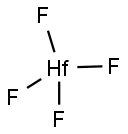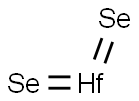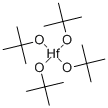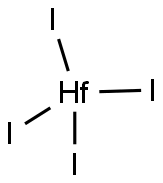HAFNIUM
Synonym(s):Celtium;Hafnium;Hafnium element;
- CAS NO.:7440-58-6
- Empirical Formula: Hf
- Molecular Weight: 178.49
- MDL number: MFCD00011032
- EINECS: 231-166-4
- SAFETY DATA SHEET (SDS)
- Update Date: 2025-01-27 09:38:02

What is HAFNIUM?
Description
De scription: Hafnium is a refractory metal which occurs innature in zirconium minerals. Molecular weight= 178.49;Specific gravity (H2O:1)= 13.31; Boiling point = 4602℃; .Freezing/Melting point = 2227℃; Vapor pressure= 1 X .10~4 mmHg at 20℃. Insoluble in water.
Chemical properties
Hafnium is a refractory metal which occurs in nature in zirconium minerals.
Physical properties
Hafnium is a ductile metal that looks and feels much like stainless steel, but it is significantlyheavier than steel. When freshly cut, metallic hafnium has a bright silvery shine. Whenthe fresh surface is exposed to air, it rapidly forms a protective oxidized coating on its surface.Therefore, once oxidized, hafnium resists corrosion, as do most transition metals, whenexposed to the air. Chemically and physically, hafnium is very similar to zirconium, whichis located just above it in group 4 on the periodic table. In fact, they are so similar that it isalmost impossible to secure a pure sample of either one without a small percentage of theother. Each will contain a small amount of the other metal after final refining.
Hafnium’s melting point is 2,227°C, its boiling point varies from about 2,500°C to5,000°C depending on its purity, and its density is 13.29 g/cm3. The compound hafniumnitride (HfN) has the highest melting point (over 3,300°C) of any two-element compound.
Isotopes
There are 44 known isotopes for hafnium. Five are stable and one of the unstableisotopes has such a long half-life (Hf-174 with a 2.0×10+15 years) that it is includedas contributing 0.16% to the amount of hafnium found in the Earth’s crust. The percentagecontributions of the 5 stable isotopes to the element’s natural existence on Earth areas follows: Hf-176 = 5.26%, Hf-177 = 18.60%, Hf-178 = 27.28%, Hf-179 = 13.62%,and Hf-180 = 35.08%.
Origin of Name
Named after Hafnia, the Latin name for the city of Copenhagen, Denmark.
Occurrence
Hafnium is the 47th most abundant element on Earth. Thus, it is more abundant thaneither gold or silver. Because hafnium and zirconium are always found together in nature, bothmetals are refined and produced by the Kroll process. Pure samples of either hafnium or zirconiumare almost impossible to separate by the Kroll or other refining processes. Baddeleyite(ZrO2), a zirconium ore, and zircon (ZrSiO4) are treated with chlorine along with a carboncatalyst that produces a mixture of zirconium and hafnium tetrachlorides. These are reducedby using sodium or magnesium, resulting in the production of both metals. The molten metalsare separated by the process known as fractionation, which depends on their different meltingpoints and densities. As the mixture of the two metals cools during the fractionation process,the denser solidified hafnium sinks to the bottom of the vessel while the less dense zirconium(with a higher melting point than hafnium) floats on top.
History
Hafnium was thought to be present in various minerals and concentrations many years prior to its discovery, in 1923, credited to D. Coster and G. von Hevesey. On the basis of the Bohr theory, the new element was expected to be associated with zirconium. It was finally identified in zircon from Norway, by means of X-ray spectroscopic analysis. Hafnium was named in honor of the city in which the discovery was made. Most zirconium minerals contain 1 to 5% hafnium. It was originally separated from zirconium by repeated recrystallization of the double ammonium or potassium fluorides by von Hevesey and Jantzen. Metallic hafnium was first prepared by van Arkel and deBoer by passing the vapor of the tetraiodide over a heated tungsten filament. Almost all hafnium metal now produced is made by reducing the tetrachloride with magnesium or with sodium (Kroll Process). Hafnium is a ductile metal with a brilliant silver luster. Its properties are considerably influenced by the impurities of zirconium present. Of all the elements, zirconium and hafnium are two of the most difficult to separate. Their chemistry is almost identical; however, the density of zirconium is about half that of hafnium. Very pure hafnium has been produced, with zirconium being the major impurity. Natural hafnium contains six isotopes, one of which is slightly radioactive. Hafnium has a total of 41 recognized isotopes and isomers. Because hafnium has a good absorption cross section for thermal neutrons (almost 600 times that of zirconium), has excellent mechanical properties, and is extremely corrosion resistant, it is used for reactor control rods. Such rods are used in nuclear submarines. Hafnium has been successfully alloyed with iron, titanium, niobium, tantalum, and other metals. Hafnium carbide is the most refractory binary composition known, and the nitride is the most refractory of all known metal nitrides (m.p. 3310°C). Hafnium is used in gas-filled and incandescent lamps, and is an efficient “getter” for scavenging oxygen and nitrogen. Finely divided hafnium is pyrophoric and can ignite spontaneously in air. Care should be taken when machining the metal or when handling hot sponge hafnium. At 700°C hafnium rapidly absorbs hydrogen to form the composition HfH1.86. Hafnium is resistant to concentrated alkalis, but at elevated temperatures reacts with oxygen, nitrogen, carbon, boron, sulfur, and silicon. Halogens react directly to form tetrahalides. The price of the metal is about $2/g. The yearly demand for hafnium in the U.S. is now in excess of 50,000 kg.
Characteristics
As the first element in the third series of the transition elements, hafnium’s atomic number(72Hf ) follows the lanthanide series of rare-earths. The lanthanide series is separated out ofthe normal position of sequenced atomic numbers and is placed below the third series on theperiodic table (57La to 71Li). This rearrangement of the table allowed the positioning of elementsof the third series within groups more related to similar chemical and physical characteristics—for example, the triads of Ti, Zr, and Hf; V, Nb, and Ta; and Cu, Ag, and Au.
The Uses of HAFNIUM
Hafnium has a great affinity for absorbing slow neutrons. This attribute, along with itsstrength and resistance to corrosion, makes it superior to cadmium, which is also used formaking control rods for nuclear reactors. This use is of particular importance for the type ofnuclear reactors used aboard submarines. By moving the control rods in and out of a nuclearreactor, the fission chain reaction can be controlled as the neutrons are absorbed in the metalof the rods. The drawback to hafnium control rods is their expense: it costs approximately onemillion dollars for several dozen rods for use in a single nuclear reactor.
In vacuum tubes and other applications that must have gases removed, hafnium is used asa “getter” to absorb any trace oxygen or nitrogen in the tube, thus extending the life of thevacuum tube. Hafnium’s qualities also make it ideal for filaments in light bulbs and, whenmixed with rare-earth metals, as a “sparking” misch metal. Hafnium is also used to a lesserextent as an alloying agent for several other metals, including iron, titanium, and niobium.
The Uses of HAFNIUM
Obtained in mining and purification of the metal; used in control rods in nuclear reactors and in manufacture of light bulb filaments; found in all zirconiumcontaining minerals
Definition
hafnium: Symbol Hf. A silvery lustrousmetallic transition element;a.n. 72; r.a.m. 178.49; r.d. 13.3; m.p.2227±20°C; b.p. 4602°C. The elementis found with zirconium and is extractedby formation of the chlorideand reduction by the Kroll process. Itis used in tungsten alloys in filamentsand electrodes and as a neutron absorber.The metal forms a passiveoxide layer in air. Most of its compoundsare hafnium(IV) complexes;less stable hafnium(III) complexesalso exist. The element was first reportedby Urbain in 1911, and its existencewas finally established by Dirk Coster (1889–1950) and Georgede Hevesey (1885–1966) in 1923.
General Description
HAFNIUM, is a grayish metallic colored powder. Dust from dry powder may be ignited by static electricity. The dry powder reacts with moisture to produce hydrogen, a flammable gas. The heat from this reaction may be sufficient to ignite the hydrogen. HAFNIUM does not appreciably react with large quantities of water.
Air & Water Reactions
Highly flammable. The dry powder reacts with moisture to produce hydrogen, a flammable gas. The heat from this reaction may be sufficient to ignite the hydrogen. HAFNIUM does not appreciably react with large quantities of water.
Reactivity Profile
Metals, such as HAFNIUM METAL(reactivity similar to zirconium), are reducing agents and tend to react with oxidizing agents. Their reactivity is strongly influenced by their state of subdivision: in bulk they often resist chemical combination; in powdered form they may react very rapidly. Thus, as a bulk metal HAFNIUM is somewhat unreactive, but finely divided material may be pyrophoric. The metal reacts exothermically with compounds having active hydrogen atoms (such as acids and water) to form flammable hydrogen gas and caustic products. The reactions are less vigorous than the similar reactions of alkali metals, but the released heat can still ignite the released hydrogen. Materials in this group may react with azo/diazo compounds to form explosive products. These metals and the products of their corrosion by air and water can catalyze polymerization reactions in several classes of organic compounds; these polymerizations sometimes proceed rapidly or even explosively. Some metals in this group form explosive products with halogenated hydrocarbons.
Hazard
Although the metal hafnium is not harmful, its powder and dust are both toxic if inhaledand explosive even when wet.
Health Hazard
Fire will produce irritating, corrosive and/or toxic gases. Inhalation of decomposition products may cause severe injury or death. Contact with substance may cause severe burns to skin and eyes. Runoff from fire control may cause pollution.
Fire Hazard
Flammable/combustible material. May ignite on contact with moist air or moisture. May burn rapidly with flare-burning effect. Some react vigorously or explosively on contact with water. Some may decompose explosively when heated or involved in a fire. May re-ignite after fire is extinguished. Runoff may create fire or explosion hazard. Containers may explode when heated.
Flammability and Explosibility
Highly flammable
Industrial uses
Pure hafnium is a lustrous, silvery metal that is not so ductile nor so easily worked as zirconium; nevertheless, hafnium can be hot- and cold-rolled on the same equipment and with similar techniques as those used for zirconium. All zirconium chemicals and alloys may contain some hafnium, and hafnium metal usually contains about 2% zirconium.The metal has a closepacked hexagonal structure. The electric conductivity is about 6% that of copper. It has excellent resistance to a wide range of corrosive environments.
Because of the startling similarity in their chemical properties, zirconium and hafnium always occur together in nature. In their respective ability to absorb neutrons, however, they differ greatly, and this difference has led to their use in surprisingly different ways in nuclear reactors. Zirconium, with a low neutron-absorption cross section (0.18 barn), is highly desirable as a structural material in water-cooled nuclear reactor cores. Hafnium, on the other hand, because of its high neutron-absorption cross section (105 barns), can be used as a neutron-absorbing control material in the same nuclear reactor cores. Thus, the two elements, which occur together so intimately in nature that they are very difficult to separate, are used as individual and important but contrasting components in the cores of nuclear reactors.
Potential Exposure
Hafnium metal has been used as a control rod material in nuclear reactors. Thus, those engaged in fabrication and machining of such rods may be exposed.
First aid
If this chemical gets into the eyes, remove anycontact lenses at once and irri gate immediately for at least15 min, occasionally lifting upper and lower lids. Seekmedical attention immediately. If this chemical contacts theskin, remove contaminated clothing and washimmediatelywith soap and water. Seek medical attention immediately. Ifthis chemical has been inhaled,remove from exposure,begin rescue breathing (using universal precautions, includ-ing resuscitation mask) if breathing has stopped and CPR ifheart action has stopped. Transfer promptly to a medicalfacility. W hen this chemical has been swallowed, get medical attention. Give large quantities of water and inducevomiting. Do not make an unconscious person vomit.
storage
Color Code- -Yellow Stripe (dry powder is a strong reducing agent): Reactivity Hazard; Store separately in anarea isolated from flammables, combustibles, or other yellow coded materials. Prior to working with this chemical youshould be trained on its proper handling and storage. Store intightly closed containers in a cool, well-ventilated area.
Shipping
UN1326 Hafnium powder, wetted with not <,25% water (a visible excess of water must be present) (1) mechanically produced, particle size<53 μm; (2) chemically produced, particle size<840 μm, Hazard Class: 4.1; Labels: 4.1-Flammable solid. UN2545 Hafnium pow der, dry, Hazard Class: 4.1; Labels: 4.1-Flammable solid. UN1346 Hafnium powder, wetted with not less than 25% water (a visible excess of water must be present) (1) mechanically produced, particle size less than 53 μm; (2) chemically produced, particle size less than 840 μm, Hazard Class: 4.1; Labels: 4.1-Flammable solid.
Incompatibilities
Fine powder or dust may form explosive mixture in air. The powder is highly flammable and a strong reducing agent. The powder or dust reacts with moisture forming flammable hydrogen gas; may spontaneously ignite on contact with moist air; and at higher temperatures, with nitrogen, phosphorous, oxygen, halogens, and sulfur; contact with hot nitric acid; heat, shock, friction, strong oxidizers; or ignition sources may cause explosions.
Waste Disposal
Recovery. Consider recycling, otherwise, this chemical must be disposed of in compliance with existing federal and local regulations.
Properties of HAFNIUM
| Melting point: | 2227 °C (lit.) |
| Boiling point: | 4602 °C (lit.) |
| Density | 13.3 g/cm3 (lit.) |
| storage temp. | Store at +15°C to +25°C. |
| solubility | soluble in HF |
| form | wire |
| color | Silver-gray |
| Specific Gravity | 13.31 |
| Resistivity | 29.6 μΩ-cm, 0°C |
| Water Solubility | soluble HF; slowly reacts with conc H2SO4, aqua regia [KIR80] |
| Merck | 13,4603 |
| Exposure limits | ACGIH: Ceiling 2 ppm OSHA: Ceiling 5 ppm(7 mg/m3) NIOSH: IDLH 50 ppm; Ceiling 5 ppm(7 mg/m3) |
| Stability: | Stable. Incompatible with oxygen, sulfur, strong oxidizing agents, halogens, phosphorus, strong acids. Highly flammable. |
| CAS DataBase Reference | 7440-58-6(CAS DataBase Reference) |
| EPA Substance Registry System | Hafnium (7440-58-6) |
Safety information for HAFNIUM
| Signal word | Danger |
| Pictogram(s) |
 Flame Flammables GHS02 |
| GHS Hazard Statements |
H228:Flammable solids |
| Precautionary Statement Codes |
P210:Keep away from heat/sparks/open flames/hot surfaces. — No smoking. P240:Ground/bond container and receiving equipment. P241:Use explosion-proof electrical/ventilating/lighting/…/equipment. P280:Wear protective gloves/protective clothing/eye protection/face protection. P370+P378:In case of fire: Use … for extinction. |
Computed Descriptors for HAFNIUM
| InChIKey | VBJZVLUMGGDVMO-UHFFFAOYSA-N |
New Products
Tetrabutylammonium iodide (3,3-DIFLUOROCYCLOBUTYL)METHANOL 4,4-DIFLUOROCYCLOHEXANAMINE Cyclobutylamine (S)-3-Fluoro-pyrrolidine hydrochloride 3-Oxocyclobutanecarboxylic acid N-Hydroxy-2-methylpropanimidamide L-tert-Leucine,97% 2-Bromophenylacetonitrile, 97% Aluminum oxide, basic Calcium hydroxide, 95% Diallylamine, 99% 2-Iodobenzoic Acid 3-Methoxybenzonitrile Pentachlorobenzonitrile Chloral Dibenzoyl Peroxide Titanium Dioxide O-Benzylhydroxylamine Hydrochloride 2-Nitrobenzaldehyde 2-Picolylamine (2-Aminomethylpyridine) 2-Venylpyridine Ethyl-2-Chloroacetoacetate 4-Dimethylamine PyridineRelated products of tetrahydrofuran








You may like
-
 Hafnium pieces, 3 to 12mm (0.12 to 0.47 in.) CAS 7440-58-6View Details
Hafnium pieces, 3 to 12mm (0.12 to 0.47 in.) CAS 7440-58-6View Details
7440-58-6 -
 Hafnium pieces, 3 to 12mm (0.12 to 0.47 in.) CAS 7440-58-6View Details
Hafnium pieces, 3 to 12mm (0.12 to 0.47 in.) CAS 7440-58-6View Details
7440-58-6 -
 Hafnium powder, <40 μm, 99.9% CAS 7440-58-6View Details
Hafnium powder, <40 μm, 99.9% CAS 7440-58-6View Details
7440-58-6 -
 Hafnium pieces, 2-3 mm, 99.9% CAS 7440-58-6View Details
Hafnium pieces, 2-3 mm, 99.9% CAS 7440-58-6View Details
7440-58-6 -
 Hafnium pieces, 4-10 mm, 99.9% CAS 7440-58-6View Details
Hafnium pieces, 4-10 mm, 99.9% CAS 7440-58-6View Details
7440-58-6 -
 Hafnium powder, -325 mesh, 99.6% (metals basis excluding Zr), Zr nominal 2-3.5% CAS 7440-58-6View Details
Hafnium powder, -325 mesh, 99.6% (metals basis excluding Zr), Zr nominal 2-3.5% CAS 7440-58-6View Details
7440-58-6 -
 Hafnium sputtering target, diam. x thickness 50.6 mm x 3 mm, 99.99% CAS 7440-58-6View Details
Hafnium sputtering target, diam. x thickness 50.6 mm x 3 mm, 99.99% CAS 7440-58-6View Details
7440-58-6 -
 Hafnium ICP standard CASView Details
Hafnium ICP standard CASView Details
